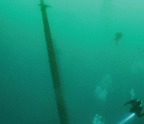The Return to the Ancient Antikythera Shipwreck of Greece



If you hear the words “ancient computer,” what comes to mind? For me, it’s a Commodore 64 – the first “computer” I used about 30 years ago as a young boy to play games and maybe even do a little BASIC programming. But if you’re perhaps of a different generation, with main frame experience maybe, such as my stepfather Frank who would be almost 90 today, then you might even think of large rooms packed with spinning roles of tape. And maybe you just happened to watch a great movie about Alan Turing and you can imagine something as ancient as a WWII computer that was used to help crack the German code – also something that filled a warehouse and had lots of cables and looked like a government-sized science project gone awry. But for some out there, the term “ancient computer” takes on a whole different meaning. For them, the world’s first computer is not 50 years old, or even 80 years old, but over 2000 years old…

Depending on your definition of computer, the Antikythera mechanism is described by some today as the world’s most ancient computer and it was discovered 170’ underwater off a small, barely inhabited island in Greece over 115 years ago. The mechanism has been the subject of many books, museum exhibitions, and more than a few mathematicians and scientists have spent better parts of their careers trying to decode and decipher what the ancient Greeks were trying to predict. If unfamiliar with the mechanism, imagine a small wooden box with a dial on the front that is very reminiscent of a modern mechanical clock, and the image continues when the box is opened and there are small and large interlocking gears that move the dials in a precise, measured fashion to predict celestial movement and other political events that were timed to the seasons.
You’re reading a preview, subscribe to read more.
Start your free 30 days



